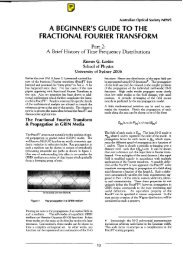3D Fourier analysis methods for digital processing and 3D ...
3D Fourier analysis methods for digital processing and 3D ...
3D Fourier analysis methods for digital processing and 3D ...
You also want an ePaper? Increase the reach of your titles
YUMPU automatically turns print PDFs into web optimized ePapers that Google loves.
line of sight. Connected segments of a rendered feature are there<strong>for</strong>e composed of voxels with comparable<br />
values. In the case of a transmission DIC focus series, when attempting to render the image data<br />
volume in <strong>3D</strong>, the shadow <strong>and</strong> highlight regions of a particular feature will have dramatically different<br />
values, hence will not, in general, appear connected.<br />
There are a number of ways around the problem of visualizing <strong>3D</strong> Nomarski DIC images. The most<br />
obvious is to convert individual DIC image slices back to something resembling bright field. For this<br />
method to be of any utility the features gained by Nomarski DIC (such as enhanced high spatial frequencies)<br />
must not be lost. The obvious way to convert from Nomarski to bright field is to reverse the<br />
(differential) DIC process, i.e., to integrate along the direction of Nomarski shear. This solution has a<br />
number of problems which are shown in Figure 2. The image at left is a single 2D slice from a confocal<br />
transmission DIC dataset of lightly-stained orchid root tip chromosomes. Figure 2 (middle) shows the<br />
result of per<strong>for</strong>ming a simple integration operation on the original DIC image. Streaks are due to difficulties<br />
initializing the integration. Worse still, the integration process is equivalent to a type of low pass filtering<br />
or blurring so that the enhanced high spatial frequencies are lost.<br />
Another way of modelling the Nomarski process is to consider it in the spatial frequency domain. In<br />
this system the (real space) differentiation corresponds to multiplication by the spatial frequency parallel to<br />
the shear. Integration is then just the inverse, namely division by the spatial frequency. Both these<br />
processes are antisymmetric (or odd) but the division selectively attenuates higher frequency components.<br />
What is needed is an antisymmetric trans<strong>for</strong>m or process which does not change the relative balance of the<br />
various frequency components. Such a trans<strong>for</strong>m exists <strong>and</strong> is known as the Hubert trans<strong>for</strong>m4. In essence<br />
the trans<strong>for</strong>m just keeps all the positive frequency components the same but reverses the sign of all the<br />
negative frequency components. The effect of the Hubert trans<strong>for</strong>m on a Nomarski image is shown in<br />
Figure 2 (right). The chromosomes which had gray/darklgray <strong>and</strong> gray/light/gray shading, on the left <strong>and</strong><br />
right edges respectively, convert to a lighter central region with dark/light transitions on one side <strong>and</strong><br />
light/dark transitions on the other side. The main effect is to "symmetrize" the image <strong>and</strong> render connected<br />
regions with similar pixel values.<br />
Figure 2. Comparison of <strong>digital</strong> <strong>processing</strong> techniques <strong>for</strong> confocal transmission Nomarski DIC images.<br />
Left: an original confocal transmission Nomarski DIC image of metaphase chromosomes from an<br />
orchid root tip preparation. Middle: the resulting image after a computer integration was per<strong>for</strong>med.<br />
Right: the resulting image after a Hilbert trans<strong>for</strong>m was per<strong>for</strong>med. Chromosome width equals<br />
approximately 1 j.Lm.<br />
The implementation of the 2D Hubert trans<strong>for</strong>m (HT) is shown schematically in Figure 3. It is possible<br />
to implement an approximate HT in real space4'5 using a special convolution kernel, but we chose the<br />
232 1SPIE Vol. 2412



